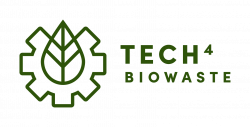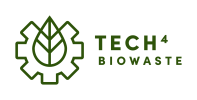Test-Technology
| Technology | |

| |
| Technology details | |
| Name: | [Technology name] |
| Category: | [Category name which is the direct link to: Pre-processing, Conversion, or Post-processing] |
| Feedstock: | [If applicable: insert links to Food waste (as well as specified example 1, specified example 2... in brackets), Garden and park waste (as well as specified examples in brackets) |
| Product: | [Product 1, product 2, product 3] |
[Technology name and short description/introduction of its basic process principles, capabilities, feedstock, product, application fields etc. The description/style can be similar in style to an encyclopaedia article.]
Feedstock
Origin and composition
[Description about which kind of relevant feedstock (biowaste) is usually processed (relevant feedstocks can be found under Biowaste, Food waste, and Garden and park waste). More information about origin and composition (chemical and physical) and how is that related to the process and product outcome (quality, advantages, disadvantages, needs for technology-/process-adaptations with respect to the feedstock composition etc.). Tables can help to give a better overview.]
Pre-treatment
[Description or list about pre-treatments that are necessary Lorem ipsum before the feedstock can be processed via the technology. Primary processing or hybrid processing might provide suitable candidates that can be linked. If they are not covered yet please provide feedback or feel free to create articles/pages for missing pre-treatments.]
Process and technologies
[Main description about the process and technologies (including process conditions etc.). The technologies might have further sub-categorisations these sub-categories are then used for the technology comparison tool and technology provider infobox under the chapter technology providers. The sub-categories can be introduced and described in subchapters as follows:]
Category 1
[Description about a special sub-category of the technology including the main features and differentiation from the other subcategories. If applies: advantages, disadvantages, limitations, differences in ability to process different feedstocks, product quality.]
Category 2
[Description about a special sub-category of the technology including the main features and differentiation from the other subcategories. If applies: advantages, disadvantages, limitations, differences in ability to process different feedstocks, product quality.]
Reactions or physical principle
[Reactions or physical principles can explained in more detail if needed. It can be considered that reactions or physical principles are explained in separate articles/pages which is useful to prevent repetitions when several technologies are based on same principles. Separate articles/pages can be linked accordingly in this section.]
Thermochemical processes and technologies
Product
[Main description about the products that are obtained including application fields, as well as potentially impacts on quality, yield etc. Sub-chapters as follows are recommended if several products are obtained:]
Product 1
[Description about the products that are obtained including application fields, as well as potentially impacts on quality, yield etc.]
Product 2
[Description about the products that are obtained including application fields, as well as potentially impacts on quality, yield etc.]
Post-treatment
[Description or list about post-treatments that are necessary after the feedstock is processed via the technology. Primary processing or hybrid processing might provide suitable candidates that can be linked. If they are not covered yet please provide feedback or feel free to create pages for missing pre-treatments.]
Technology providers
[This chapter begins with the technology comparison tool that includes obligatory information. The comparison tool is customised for each technology (since especially the datafields for technology and process details as well for the feedstock and product need relevant/suitable fields).]
| Company name | Country | Technology category | Technology name | TRL | Capacity [kg/h] | Detailed information 1 [unit] | Detailed information 2 [unit] | Feedstock: Food waste | Feedstock: Garden & park waste | Product: Product 1 | Product: Product 2 | Product: Product 3 |
|---|---|---|---|---|---|---|---|---|---|---|---|---|
| Company 1 | Italy | Test-technology | Techno-tron | 9 | 100 | ● | ● | |||||
| nova-Institut für politische und ökologische Innovation GmbH | Germany | Test-technology | novas ValorTech | 4 | 55000 | ● | ● | ● | ||||
| Company 3 | France | Test-technology | Waste2X | 5 | 80 | ● | ● |
Company 1
| General information | |||
| Company: | [Company name] | 
| |
| Country: | [Country HQ location] | ||
| Contact: | [e-mail address] | ||
| Webpage: | [URL] | ||
| Technology and process details | |||
| Technology name: | ["Brand name"] | Technology category: | [Secified technology sub-category from chapter process and technologies] |
| TRL: | [4-9] | Capacity: | [numeric value] kg·h-1 |
| Obligatory detail 1: | [Detail 1] [unit] | Obligatory detail 2: | [Detail 2] [unit] |
| Obligatory detail 3: | [Detail 3] [unit] | Other: | [Other information, free to choose] |
| Feedstock and product details | |||
| Feedstock: | [more specified feedstocks, (if possible: link to feedstocks from biowaste, garden and park waste, and food waste)] | Product: | [more specified products, (if possible: link to products)] |
[Coherent text including the following set of information]
nova-Institut für politische und ökologische Innovation GmbH
| General information | |||
| Company: | nova-Institut für politische und ökologische Innovation GmbH | 
| |
| Country: | Germany | ||
| Contact: | contact@nova-institut.de | ||
| Webpage: | www.nova-institute.eu | ||
| Technology and process details | |||
| Technology name: | novas ValorTech | Technology category: | Pre-processing |
| TRL: | 4 | Capacity: | 55000 kg·h-1 |
| Obligatory detail 1: | [unit] | Obligatory detail 2: | [unit] |
| Obligatory detail 3: | [unit] | Other: | From our process we are obtaining several by-products including X, Y, Z |
| Feedstock and product details | |||
| Feedstock: | Different kind of biowaste, garden and park waste, and food waste)] | Product: | Polymers including PLA, PHA, PE, PP and PBS |
The nova-Institut GmbH is a private and independent research institute which was founded in 1994. nova has a multidisciplinary and international team of more than 40 scientists. The company offers science-based research and consultancy with a focus on the transition of the chemical and material industry to renewable carbon. One of the main topics are therefore the possibilities to substitute fossil carbon with biomass, direct CO2 utilisation and recycling. nova offers a unique understanding to support the transition of your business into a climate-neutral future.
In 2020 the Renewable Carbon Initiative (RCI) was launched by nova. The aim of the Renewable Carbon Initiative (RCI) is to support and speed up the transition from fossil carbon to renewable carbon for all organic chemicals and materials. RCI addresses the core problem of climate change, which is extracting and using additional fossil carbon from the ground that will eventually end up in the atmosphere. Companies are encouraged to focus on phasing out fossil resources and to use renewable carbon instead. The initiative wants to drive this message, initiating further actions by bringing stakeholders together, providing information and shaping policy to strive for a climate-neutral circular economy.
Company 3
| General information | |||
| Company: | Company 2 | Webpage: | www.company2.eu |
| Country: | Belgium | Contact: | katrien.molders@company2.eu |
| Technology name: | test-technology | Technology category: | chemical processes |
| TRL: | 7 | Capacity: | 500kg/h kg·h-1 |
| Technology and process details | |||
| Atmosphere: | 10 bar | Catalyst: | A tasty brown beer |
| Heating: | Yes please! | Pressure: | None please bar |
| Reactor: | 10000 L | Temperature: | 25°C °C |
| Other: | None | ||
| Feedstock and product details | |||
| Feedstock: | Chocolate cake | Product: | bio-flavours |
[Coherent text including the following set of information]
Open access pilot and demo facility providers
[Insert here suitable links from the list of the Pilots4U Database.]